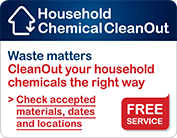Chemicals in the home
How to safely use, store, and dispose of dangerous household chemicals, and the hazardous substances like asbestos you may encounter during home renovations.
In most cases, it is possible to
- reduce overall use of chemicals
- switch to products that are less hazardous
Sometimes there is no alternative to using hazardous chemicals. In these situations it is important to know what preventative steps to take to minimise harmful exposure.
This page provides links to that provide information on using chemical-based products safely and responsibly.
Note that the EPA does not endorse in any way, or make any representations in relation to, any information, products or companies named or listed in the following websites or publications. You should make your own inquiries.
Domestic products containing chemicals include
- paints and varnishes
- cleaning agents (such as detergents)
- cosmetics and hygiene products
- weed killers, insecticides and baits
- wood, pool and pet treatments
There are many changes you can make in your everyday life to avoid health and environmental risks.
- Household chemical safety: Tips for safe chemical storage and use from Fire and Rescue NSW.
- Prevention of poisoning: Things to be aware of with regard to household chemicals and medications and how to minimise the risk of poisoning.
- Hazardous household waste: Details for the Household Chemical CleanOut program including dates, venues, what materials can be collected, and tips on how to transport the chemicals safely.
Pest control
- Using pesticides: Things you should know about using pesticides and how they are regulated by the EPA.
- Controlling pests around the home: The US Environmental Protection Agency’s domestic pest control ‘dos and don'ts’ for parents and teachers.
-
Natural alternatives to synthetic chemicals: the WA Department of Primary Industries and Regional Development guide to using natural remedies for pest control.
When renovating your home, you can choose safer and more sustainable products for new work. You may encounter older building materials such as asbestos and lead paints, which can be harmful to your health. Taking precautions will help lower the risk of exposure.
- Find out about safely handling and disposing of household asbestos and lead paint, deconstructing your house and working with treated timber.
- Lead - your health around the home (PDF 228KB) and Lead - gardening and home renovations (PDF 217KB). These factsheets provide information about potential sources of lead in and around your home, and how to deal with them safely (See lead safety for general information about lead).
- Building and industry hazards: The NSW Health portal provides information on environmental health issues including home renovation, chemicals and asbestos.
- Asbestos in the home: Information about how to find and manage asbestos in and around the home.
